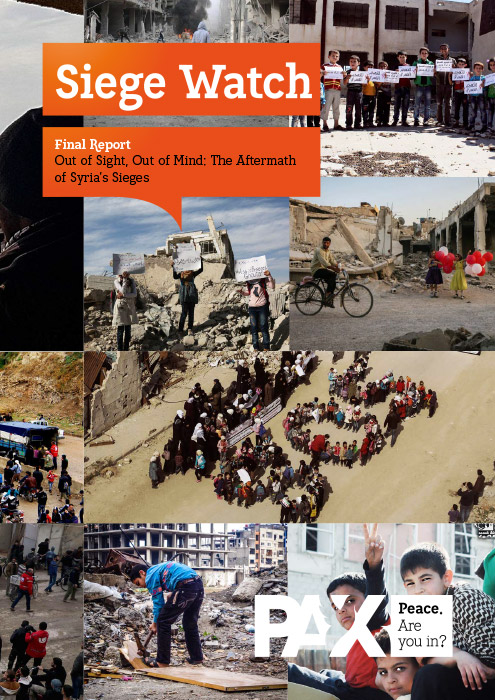The sieges in Syria are over. But the impact of sieges continues to be felt, and will be for many years to come.
The Assad regime used sieges as part of a widespread strategy to force opposition-held areas to surrender. But the strategy involved war crimes and crimes against humanity. The perpetrators of these crimes must be held accountable.
“Many sieges ended in forced population transfers, a war crime,” says PAX programme lead Marjolein Wijninckx. “Hundreds of thousands of siege victims are today displaced in northern Syria or in exile in Turkey or other countries. While the regime that forcibly displaced them is in power, they cannot return home or claim their property rights.”
Final Siege Watch report
The final Siege Watch report, “Out of Sight, Out of Mind: the Aftermath of Syria’s Sieges,” published today, offers a summary of six years of sieges and considers the current needs of the victims. The report also draws conclusions about the strategy of sieges, and offers recommendations – both about what to do now to help the victims, but also what the international community can do in the future to protect civilians.
Two-and-a-half million people, or ten percent of the pre-war Syrian population, were victims of sieges, of a man-made humanitarian disaster of historic proportions. These military and economic blockades were imposed on civilian populations, and forced people to live cut off from electricity and running water, deprived of food, fuel, medical supplies and other basic necessities. Hospitals, schools, markets and relief supplies were targets of attack. Many besieged communities were subjected to devastating attacks, and some were demolished under scorched earth campaigns. This was all part of a premediated, carefully executed strategy of war.
Besieged areas still being punished
For the Assad regime and its allies, the siege strategy was effective. Today, Assad and his allies control all the areas once under siege. But the regime continues to restrict humanitarian access to these areas and limits freedom of movement of people from these areas. It also targets these communities with repressive tactics such as arrest campaigns. “It is crucial that independent monitoring takes place in formerly besieged areas,” says Wijninckx. “Humanitarian actors should exert more pressure to get access to these areas. Their first priorities must be civilian protection and support to siege victims.”
Brussels conference
International donors will come together in Brussels next week to pledge support for Syria and neighbouring countries. PAX urges them to secure health services, psycho-social support and access to education for siege survivors inside and outside Syria. European countries should also support siege victims to achieve accountability and justice, including support for international accountability mechanisms such as the Independent, Impartial and Independent Mechanism set up by the UN to investigate and prosecute crimes committed during the war. European countries should also expand the possibilities for universal jurisdiction, and ensure funding for Syrian organisations working on justice.
Siege Watch Final Report: Out of Sight, Out of Mind: the Aftermath of Syria’s Sieges
Policy brief
PAX also published a policy brief today describing the legal obstacles to housing, land and property rights that have been put in place in Syria since 2011. There has been international criticism of zoning Law No. 10 that was introduced in 2018. This policy brief shows that there are many laws that have been introduced in the past years that have the effect, by specific design or as a by-product of another goal, of creating obstacles for returning Syrians to recover property that was in their possession prior to the conflict. Download Legal Obstacles to Housing, Land and Property Rights in Syria




